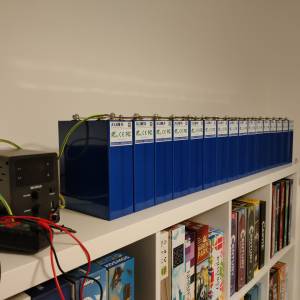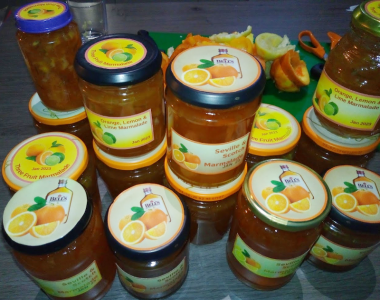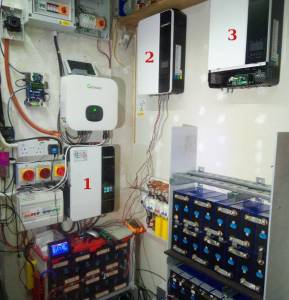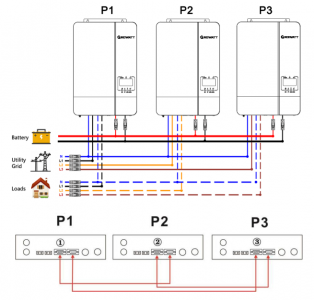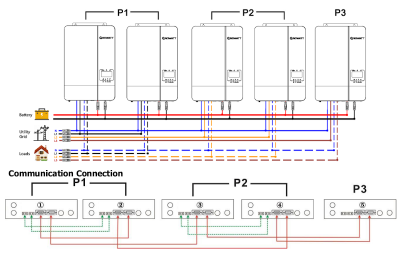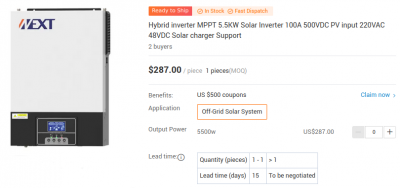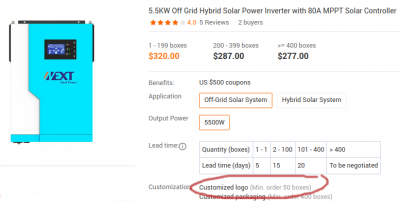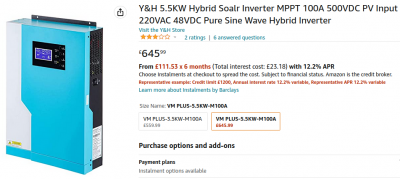@transparent they are all in parallel. I only did the sets of 4 to decrease the total time to get them all up. In parallel I can only get 36w into them at a time. With 4S @ 14V I can get 4x the power into each cell Vs via 16. So I did a rough and dirty with the sets of 4S and then a final with 16P @ 3.6V
I read that the final bit of charge to top balance is best added when the cells are under compression (e.g. within the Seplos box but not hooked up to the BMS) as to prevent any unfortunate swelling; any thoughts?
@korwraith I would not be able to do that as my charger doesn't go high enough. Makes sense to me though
Posted by: @bataltoI would not be able to do that as my charger doesn't go high enough...
Put it on a shelf, perhaps?
Apologies, it's Friday.
I'll stop making puns, and instead make another batch of marmalade.
There's not many Seville oranges around this year.
Fortunately I bought 10Kg in a local greengrocers.
Save energy... recycle electrons!
Save energy... recycle electrons!
Just wondering what Hybrid inverters you guys are using with the LV battery kits? I'm struggling to find a 3 phase one that will talk to this kit. Any suggestions?
That question is more complex than it first appears @mookyfoo
Let's start with what I hope is the most positive direction in which you could proceed:
I've been running a Growatt SPF5000ES for the past year. The trial is now being expanded to encompass multiple units, initially still to be operated from a single-phase grid supply.
The photo shows "work in progress". The wall-space currently occupied by the grid-tied Growatt MIN 3600TL will later be relinquished in favour of another hybrid off-grid inverter.
A multi-inverter installation requires connecting data and balancing wires between the units.
They must share a single battery-bank, but this can be segregated into two or more physical batteries, each with its own BMS.
The SPF5000ES can also be wired to support 3-phase operation using a minimum of three inverters. (Split phase use is not supported).
Here's a wiring diagram from page-28 of the User Manual
The wiring diagrams are not 100% accurate, sometimes showing link-wires connected to ports which are actually the wrong way around.
However, the data cables do at least have male and female ends, which makes it 'impossible' to get these wrong!
The User Manual is less clear on the way in which the inverter's parameters must be configured.
Once the command is given for them to operate as a set, they are powered down and then re-started.
At that point one unit powers up as the Master, and replicates its settings to the others.
Since you can't define which is to be the Master unit, I assume that all the other parameters must be manually configured before this re-power sequence.
If not, then a 'wrong' parameter which happens to be on the unit which declares itself as 'Master' will thence be sent to the Slaves.
Beware too that some parameters will apply to each inverter in the set, whilst others might be divided across the number of inverters that you've installed.
Eg, specifying the battery charge current at 70A, means that each inverter will contribute that amount.
It's all to easy to exceed the maximum specification for your LiFePO4 cells.
Think about a 3-phase installation with uneven numbers of inverters across the phases, and you'll begin to realise the difficulties in knowing which parameters do what!
Finally, yes I'm pretty sure that there are other (Chinese made) off-grid hybrid inverters which could be used similarly.
But I'm having great difficulty in discovering which these are.
I spent a while looking into those made by Shenzhen Next Power Technology which have a similar specification to Growatt's SPF5000ES
However I discovered that at present the Next hybrid-inverters
- don't have any firmware or interface for parallel operation (even on single-phase)
- do not meet CE & or UK safety requirements for their 240v AC connections
This situation may change. After all, Growatt bought in that parallel capability, which is why it's implemented via a separate module.
So, why do I think that there are other hybrid inverters with 3-phase capability?
Because they're used inside other large off-grid stand-by battery units being sold (at a hefty price) for use as emergency supplies.
Save energy... recycle electrons!
@transparent Thanks for that post. I wasnt aware you could share one battery across 3 inverters which could be useful. I have seen 3ph hybrid inverters available which presumably makes installation bit easier than 3 separate inverters, but they arent of a brand that is listed as supported by the Selpos kit. It just seems like there isnt enough standardisation across the manufacturers if there were you could just pick and chose what to use which would make life easier.
@mookyfoo - there isn't even enough consistency within Growatt, let along hoping for standardisation across manufacturers.
There's a high proportion of inverters which are actually made by a single manufacturer, but then loaded with different firmware and rebadged.
For example, this model manufactured by Next Technology in Shenzhen
can be found advertised on Amazon UK under three different brand names.
None of the three have modifications to add approved cable-clamps for the 240v connections, and none state what firmware variants they may or may not have.
In this particular case, the enclosure is distinctive, and the model is traceable back to Next Technology.
But most other instances of rebadged inverters, there are variations which are sufficiently different that it isn't possible to identify the original manufacturer with any great certainty.
That creates difficulties when trying to assess whether a particular model is suitable for linking in a 3-phase installation.
Since off-grid inverters contain their own 50Hz clocks, it is extremely important that they maintain 120 degrees phase difference when generating from stored energy in the battery.
A software error or thermal protection fault could too easily take one inverter off the system, resulting in possible damage to 3-phase load-devices such as a heat pump.
Only the original manufacturer will be able to know the features within the firmware of the various models they produce, and how they fail safe under fault conditions.
Returning to the Growatt SPF5000ES hybrid off-grid inverters, I will be testing these under external software controls for several months before even considering the move to a 3-phase configuration.
There are just too many ways in which one inverter within the inter-linked set might fail to implement a legitimate command.
At this moment, Growatt themselves do not specify which commands need only be sent to the Master unit in the set, and which must be sent separately.
The situation is complicated further once you consider the range of fault/alert codes which any one inverter might throw up.
These aren't initiated by software under my command, and yet must be handled appropriately.
On the matter of using a single storage battery for 3-phase off-grid use, I can't see how it would be safe to consider using separate batteries for linked inverters.
If each inverter in the set was drawing power from a different battery, then the thresholds for sensing State of Charge (SoC), High-volt overcharge, and Low-volt discharge will slightly differ.
That would simply add to the complexity of fault-handling across the inverters generating the 3 phases.
Please do continue to look for other hybrid off-grid inverters which might be suitable for use with the Seplos Mason box, or similar.
We can then discuss here whether the design contains the necessary protections and fail-safe firmware.
Save energy... recycle electrons!
I know they are furiously expensive and enormous, but I’ve been running on Outback products exclusively since 2007 without a single issue.
utterly reliable kit.
Off grid on the isle of purbeck
2.4kW solar, 15kWh Seplos Mason, Outback power systems 3kW inverter/charger, solid fuel heating with air/air for shoulder months, 10 acres of heathland/woods.
My wife’s house: 1946 3 bed end of terrace in Somerset, ASHP with rads + UFH, triple glazed, retrofit IWI in troublesome rooms, small rear extension.
- 26 Forums
- 2,406 Topics
- 54.6 K Posts
- 417 Online
- 6,092 Members
Join Us!
Worth Watching
Latest Posts
-
RE: Speedcomfort radiator fans
It's not a hijack, it's a good question. Without testin...
By Deltona , 1 minute ago
-
RE: Recommended home battery inverters + regulatory matters - help requested
I used the term head like I heard the electricians use ...
By Batpred , 56 minutes ago
-

RE: Post-Traumatic Heat Pump Stress Disorder
@jamespa, we have got this topic, which all the mods ca...
By Mars , 1 hour ago
-

RE: Sunsynk Whole House Backup Issue
Hi @lostandconfused - you're in luck.And you're quite r...
By Transparent , 1 hour ago
-

Things have gone quiet with you @drei. Any updates?
By Mars , 2 hours ago
-
RE: Considering MLCP (Multi-Layer Composite Pipe) for ASHP
@editor Lots of good info in that post. Have you or any...
By Deltona , 2 hours ago
-

RE: Passiv Smart Thermostat - Help & Forum Support
Thanks @tim441. Interesting timing, as Passiv are a cur...
By Mars , 3 hours ago
-
Hi everyone, I have a two year old Marlec Solar iBoos...
By Tallmarc , 6 hours ago
-
RE: Please help with the settings ecodan
Are you trying to address any particular performance is...
By Sheriff Fatman , 12 hours ago
-
RE: Solis inverters S6-EH1P: pros and cons and battery options
🤣 Well, I never managed to get the HA solis "...
By Batpred , 13 hours ago
-
RE: Experience - New Build / Complete New Heating System
Your sap clculations should give you a heat loss figure...
By JohnnyB , 13 hours ago
-
RE: Vaillant aroTherm not heating with many faults
@editor hmmm, our engineers Rae, Craig, Naz, Rob and Ry...
By ASHP-BOBBA , 14 hours ago
-
RE: I’m glad the cold spell is over!
@editor as a reply for this date the 6th of Jan in o...
By Nursethescreens , 16 hours ago
-
RE: Heat loss based on gas usage
@jamespa Thanks. The numbers posted above were jus...
By Bash , 16 hours ago
-
RE: Heat pump not reaching flow temperature
I would describe this as either a fault or a configurat...
By JamesPa , 17 hours ago
-

RE: New Daikin 11kW Altherma 3M install - is it working as it should?
I forgot to mention: Octopus measured our heat loss at ...
By Toodles , 20 hours ago
-
RE: Air source heat pump roll call – what heat pump brand and model do you have?
Forum Handle: @davec Manufacturer: Peak Energy Mode...
By DaveC , 20 hours ago
-
RE: Octopus Cosy 12 Heat Pump Regret: Incredibly Loud, Poor Heating & Constant Hum - Help!
Well, the guy came out, turned the heat pump to max, we...
By razz , 20 hours ago
-
Midea R32 setup and bizarre running with lengthy off periods?
Hi I am new to the world of ASHP and have just had a re...
By Countryman Helmsley , 21 hours ago

